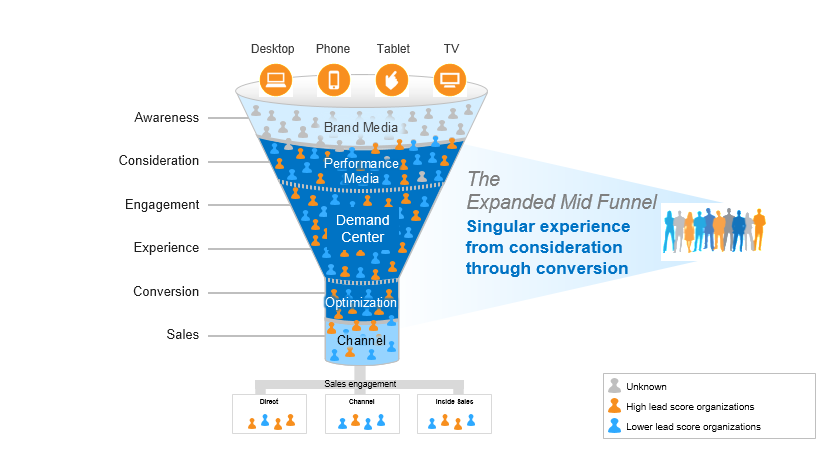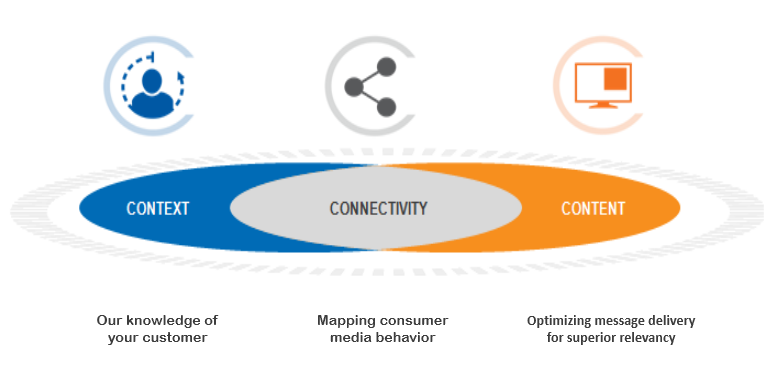Think about the traditional funnel. For B2B and B2C companies, various forms of media, such as TV advertising, print, and online ads, drive incremental activity to the top of the funnel. Sales and channel activities are focusing on increasing conversion and driving results in the bottom of the funnel. The traditional CRM (customer relationship marketing for those in B2C) or Demand Center (for those in B2B) activities have been focused in what we will call the addressable mid-funnel, and it tends to be the most challenging and often over-looked phase in the buy cycle. However, with increased relevance, engagement, and focus, it can quickly drive profitable marketing results.
As the ability to leverage dynamic information in the marketing and sales process is becoming more advanced and connected, the addressable mid-funnel is expanding, providing more opportunity to finely tune marketing programs. At the top of the funnel, we now have the ability to use performance media for improved targeting. Optimization tools in the lower funnel provide more information to the sales force, driving more directed, targeted leads or sales-qualified leads down into the funnel. With these advances, the objective now is understanding what the available addressable marketplace is within the mid-funnel and taking action to drive incremental value into your sales organization. With advancements in addressable media and data, the fact is that you can identify your most valuable customers, segments, and personas earlier in the cycle which delivers better nurturing, optimizing those leads for your sales organization.
The emerging opportunity of addressability at scale (AAS) is the executional advantage of B2P marketing. AAS is defined as the opportunity to create competitive advantage through the ability to deliver targeted, personalized experiences to people and this is forcing change in how we communicate with customers. With the emergence and dominance of digital channels, it is now possible to move your contacts from anonymous to known earlier in the funnel, developing journeys that are tailored, and driving them to a successful conversion.
To deliver this experience, B2B marketers need to rethink their content marketing strategies in what we call the three Cs of the addressable customer experience.
Context
The three Cs begin with the notion of context. In its simplest form, context in the world of digital media and channels refers to our knowledge about the individual – who she is (identified or anonymous), where she is, what she’s doing, her stage in the purchase process, whether we have a relationship with her, her current and potential value, etc.
Content
The second C is for content. Once you understand with whom you’re engaging, you must decide with what content – the stories, the advice, the offers, the messages, and the creative that drives increased customer engagement. It is the substance of that experience that differentiates your message and ideally delivers relevance within the context of that customer (or prospect).
So, how do you know all of this?
Connectivity
That’s where the notion of the third C, connectivity, comes in. Connectivity is the intersection of context and content. Now that you understand the customer, how do you engage with her? Connectivity is the point at which we link content together in the context of the consumer, delivering it where the customer wants to be, seamlessly. Connectivity is where we use new platforms and channels to communicate with customers in appropriate ways that progress to conversion. In essence, this is the customer journey.
Throughout this process, the journeys derived by the customer will feel truly tailored to them. These journeys ensure that your messages are delivered through relevant advertising, search and social communications – and that you have the ability to capture new connected data points all along the way. Your ability to “connect the dots” and deliver on the promise of an enhanced customer experience depends on how well you embrace the three Cs in your marketing engagement efforts.






Dave got me thinking: One remaining difference between B2C and B2B is that B2B buyers typically are part of a team – and the analytics required to coordinate the 3 Cs amongst them is not an easy task. The addressability of the mid-funnel does make it theoretically possible. Now there’s a case study I’d like to read.
Hello Dave,
While I appreciate the Three C’s framework, I’m taking a contrarian stance on the funnel discussion.
In my private CMO communities, Marketing is accepting a growing number of customer experience responsibility. This includes the increasingly important post-sale activities that create and nurture your customer evangelists.This is not even represented on the funnel diagram.
If a marketing organization thinks it’s their job to move a prospect through a cone-shaped funnel, they will fail at building and nurturing evangelists and loyalists. The funnel assumes that marketing’s job is complete when the customer/member makes a purchase.
Memorable customer experiences are about delivering on your brand promise as your products and services continue to evolve. I encourage my clients to envision their customer relationship as an infinity image, not a one way funnel with revenue as the end game.
You can read more about this in my newest book, “The Mindful Marketer: How to Stay Present and Profitable in a Data-Driven World.”
I like the Context / Connectivity / Content model. One of my clients has a similar schema, though they use ‘Communication’ in place of ‘Connectivity.’ Regardless, it has value in many places, especially for e-learning and channel-centric selling where there are many moving pieces and parts for marketing and business development.
Still, like Lisa, I struggle with the relevancy of the funnel concept. It’s been around ever since I’ve been in business development, but I believe that vendors have more contemporary understandings that make the linear, one-directional notion of the funnel a flawed representation. While salespeople warm to the goal-orientation inherent in the funnel, project teams on the customer side don’t always work that way. So, if you overlay the vendor-conceived funnel on a project workflow (there are many idealized versions), you will immediately see that there are significant incongruities. I have seen it cause plenty of friction. Mea culpa.
Yet, in IT and other industry verticals, the non-linear, often recursive ‘buying landscape’ characterizes what we are selling into. The path (I use the term loosely) branches in new directions as customer strategies, goals, and objectives change. The funnel model assumes a degree of stasis that cannot always be assumed.
Where I see great opportunity in selling is with companies that effectively re-imagine the steps toward accomplishing a sale, and make it more congruent with what actually happens on the customer side. That doesn’t mean dumping funnels from our parlance, but at the very least, there should always be the caveat that – like most models – funnels are a sanitized, reductive version of the truth. As Lisa points out, that also includes developing new concepts for when buying begins and when it ends. ‘Infinity’ seems a long time, but I think it’s a better notion than saying ‘mission accomplished!’ as soon as the purchase transaction is made.
Thanks for the feedback!
The Demand Generation teams core function is to drive opportunities to sales or channel, their secondary function is to assist in retaining clients and/or cross or upselling to them (starting the funnel anew) the funnel is not singular for a contact or a company either. There will be a host of concurrent funnels in play be that for multiple products, solutions or business lines and tying those multiple funnels together at an account and contact level leveraging “connective” capabilities allows a more holistic view of what is happening and aids the sales and business teams to more accurately react and make appropriate decisions. In many cases grouping these multiple buying paths can help create a more fruitful offering for the client and for the business.
I like to think of the buyers journey as the customers experience and the funnel as the internal tracking mechanism for a portion of that journey. You hope in the perfect world that you can get them from awareness to sale with no deviation and you measure along that line but the reality is very different as you point out. Hence the importance of connectivity. Please see our view on a prototypical Buyers Journey. Typically we would start here with our clients and then personalize based on multiple factors within their business such as market conditions, product types, values, sales cycles, brand awareness, customer history, account type etc.